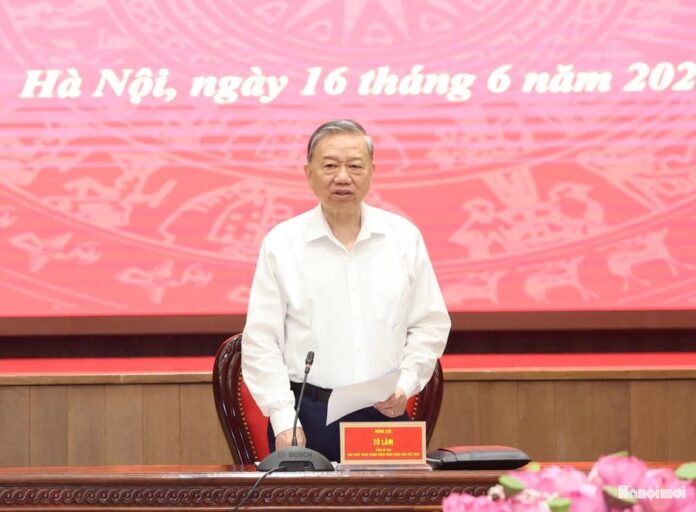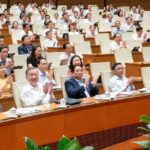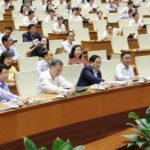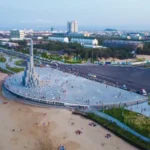On the morning of June 16, in Hanoi, General Secretary To Lam and the Central Work Delegation worked with the Hanoi Party Committee Standing Board on the results of implementing the resolutions and conclusions of the Central Committee; the rearrangement of the city’s apparatus; stabilizing the city’s situation in all aspects; national defense and security; leading the task of economic growth; social security; and implementing the two announcements of the Central Committee’s Office about the results of the General Secretary’s visit and work with the Hanoi Party Committee Standing Board.
HANOI NEEDS TO TRANSFORM INTO A CREATIVE CITY WITH CREATIVE HUMAN RESOURCES
Highly appreciating the strong efforts, the spirit of determination for innovation, creativity, and effective action of the Hanoi Party Committee, People’s Council, and People’s Committee in the past time, the General Secretary made it clear that Hanoi, with its position as the capital, the administrative-political-economic-cultural-scientific center of the country, although not subject to the merger of provincial-level administrative units, cannot and should not stand outside.
Hanoi needs to take the lead, be more proactive and bold in self-organizing and streamlining its apparatus, not only due to internal requirements but also to set an example, lead, and inspire reforms for the whole country.
Streamlining should not only stop at reducing head offices but also move towards restructuring functions and tasks, reducing intermediate layers, eliminating overlaps, and standardizing public administration procedures towards digitization, transparency, clear delegation and decentralization, and accountability.
The General Secretary noted that as the capital – the heart of the country, Hanoi needs to set higher goals and standards and have a greater aspiration for development, making a significant contribution to the country’s overall goal. It is necessary to urgently complete the rearrangement of the apparatus according to the model of a two-level local government, ensuring compliance with the spirit of Resolution 60 and Conclusion 150 of the Politburo.
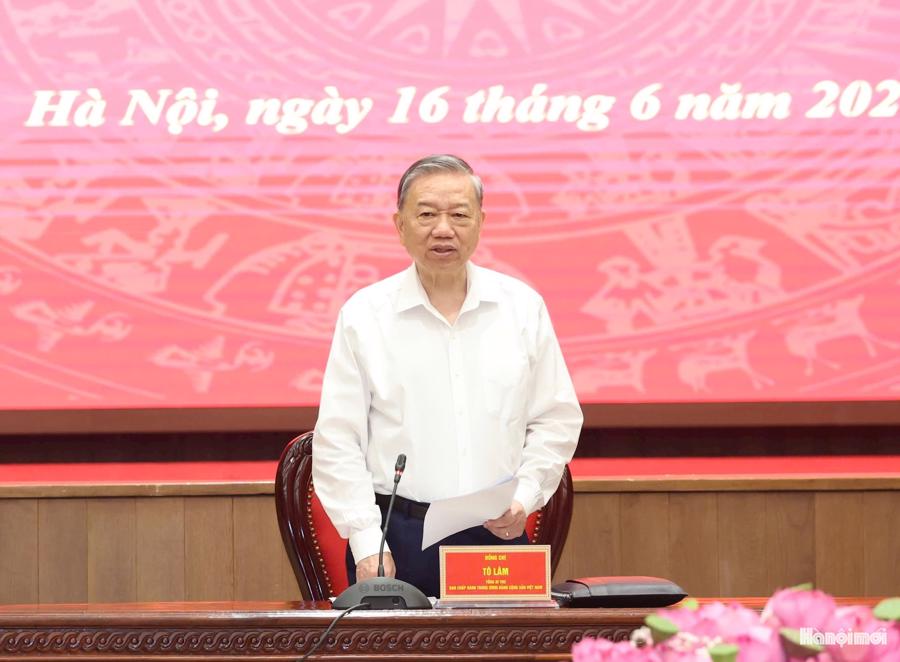
The reorganization must be carried out according to the principles of compactness, effectiveness, efficiency, transparency, smooth operation, with uniform guidance from the city to the grassroots level, and full compliance with the resolutions, conclusions, and regulations of the Central Committee. The Hanoi Party Committee should pay special attention to arranging suitable personnel after the rearrangement.
The General Secretary requested Hanoi to establish a new economic identity based on knowledge, technology, and innovation. Industries such as creative industry, fintech, smart logistics, high-quality healthcare and education, and experiential tourism must become the main drivers of growth.
Hanoi also needs to boldly experiment with new development spaces, considering the night-time economy as a diverse cultural-consumption component. Circular economy and green economy are commitments to a responsible future.
The creative urban model is a platform for social innovation. Key areas need to be reorganized not only to develop faster but also to attract talents, where researchers, entrepreneurs, artists, and designers find both good living conditions and career development opportunities.
The General Secretary pointed out that Hanoi needs to transform into a creative city, where creative human resources, new ideas, and new technologies are prioritized. This is also the time when the capital needs to look beyond its borders, not to imitate but to select and integrate the essence of global cities into its unique identity.
The vision for Hanoi’s development is not just to lead the country but to make our thousand-year-old capital a pioneering and attractive city in Asia.
REDESIGN TOWARDS OPENNESS, MULTIPLE CENTERS, AND REGIONAL INTEGRATION
The General Secretary suggested that Hanoi needs to redesign its development space towards openness, multiple centers, and regional integration so that the capital can lead the development of the North and the country.
Redefining the role and function of satellite towns such as Son Tay, Hoa Lac, Xuan Mai, and Phu Xuyen… not just as “population dispersal areas” but as regional economic-cultural-technological centers with their own attractions, good governance, and the ability to create high-quality jobs. Hanoi needs to implement mechanisms, policies, planning, and decentralization along with specific urban governance models so that these areas can grow, have their own appeal and vitality.
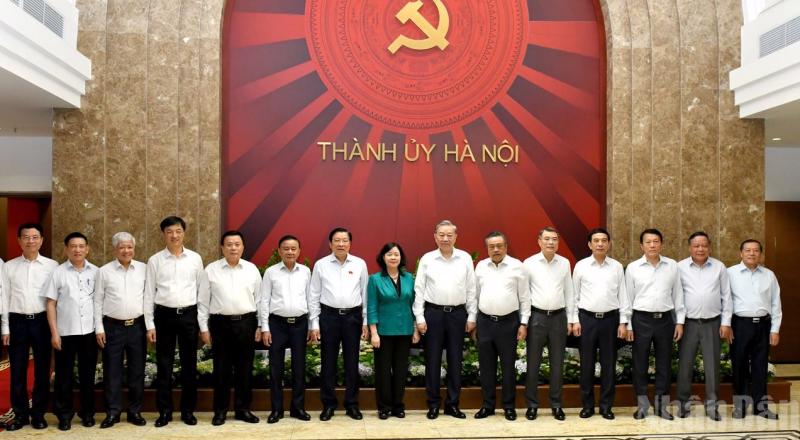
Along with this is the urgent task of re-establishing a diverse connectivity infrastructure, not just ring roads and expressways, but a long-term vision of an integrated transport network for the capital region…
Hanoi needs to transform rural areas from a role of urban logistics to a smart green belt that combines safe, high-tech agricultural production, ecological preservation, landscape, cultural preservation of villages, and experimentation with circular economy models, experiential agriculture, and indigenous tourism.
As the center of the capital region, Hanoi needs to put in place inter-provincial cooperation programs on logistics, education, digital transformation, tourism, green economy, and circular economy… in the new administrative-economic context, where Hanoi becomes the nucleus that shapes the common regional development ecosystem.
The General Secretary noted that if Hanoi cannot break out of the form of a central city with a large periphery, it will hinder its own future. But if Hanoi develops with a space as an open, intelligent, harmonious, pervasive, and distinctive ecosystem, the capital can not only develop for itself but also lead the take-off of the whole region, promote the development of the North and the country in the new era.
The General Secretary suggested synchronously and deeply implementing Resolution 15, from the master plan for the capital region to the construction of a smart city, from creating a creative city to modernizing public administration, ensuring transparency, serving the people and businesses, and transforming from a managing government to a creative and accompanying one.
Hanoi needs to proactively propose, design, and implement special pilot mechanisms and can only break through by innovating governance and technology, removing barriers and inertia…
Hanoi can and should build world-class innovation centers that generate new ideas, technologies, and new business models.
PROACTIVELY REMOVE INSTITUTIONAL BARRIERS THAT HINDER THE DEVELOPMENT OF PRIVATE ENTERPRISES
Hanoi needs to proactively remove institutional barriers hindering the development of private enterprises, from accessing capital and land to investment procedures, bidding, land leasing, and technology innovation. But more importantly, Hanoi needs to redesign the relationship between the government and businesses, shifting from a “request-grant” mechanism to a “companion-creator-shared responsibility” relationship.
Hanoi must nurture a new generation of entrepreneurs who are not only good at doing business but also have a sense of social service, a global vision, and responsibility for the nation.
Hanoi needs to actively participate in the competition among major global cities in attracting talents, innovation, and influence in terms of economy, culture, society, as well as living, studying, and working environment.
The General Secretary suggested that Hanoi should be oriented to be a center of innovation, finance, technology, and culture, with its unique identity of Vietnam but deeply integrated into the global urban network and shaping the image of a “green, smart, livable, and internationally attractive capital.”
Developing Hanoi cannot rely solely on political determination but needs the participation of the whole society. Every public space, every cultural product, every typical work, and every development policy need to be designed with the awareness that we are together shaping the image of Hanoi not only for today but also for the next century.
The General Secretary suggested turning the process of preparing for Party Congresses at all levels into a great intellectual, spiritual, and developmental mobilization so as to shape a new vision for the capital in the new era.
The 18th Congress of the Hanoi Party Committee will not only look back on a term but must also be a draft for a development journey towards 2030, 2045, and beyond.
Hanoi needs to seriously summarize the term 2020-2025, not avoiding shortcomings, not formalizing achievements, but deeply analyzing bottlenecks in institutions, planning, governance, digital transformation, human resources quality, and organizational implementation.
Each evaluation must lead to a specific action, and each lesson must be transformed into a clear orientation. Personnel work is not just about the structure of representatives but about choosing people with enough heart, vision, talent, and strength to carry the transformation of the capital in the new period.
The General Secretary hoped that the 18th Congress of the Hanoi Party Committee would be a congress of innovation, intelligence, integrity, unity, and action, and would be the greatest attraction to attract talents, unleash resources and motivation, and inspire the spirit of dedication to the capital in the whole society.
The General Secretary believed that Hanoi would overcome all challenges, strongly promote its potential, maintain its pioneering role, and continue to shine as a modern, creative, and humane capital, worthy of being the heart of the nation and a typical image of a successful Vietnam in the new era.
HANOI PROMOTES “GREEN, DIGITAL, AND CIRCULAR ECONOMY” TRANSFORMATION WITH THREE PILLARS
According to Hanoi Party Committee Secretary Bui Thi Minh Hoai, towards the 18th Congress of the Hanoi Party Committee for the term 2025-2030, the Hanoi Party Committee paid great attention to innovating thinking in the preparation of congress documents, especially in drafting the political report, closely following the guidelines and views of the Party, especially the four strategic resolutions of the Politburo (Resolution No. 57-NQ/TW, Resolution No. 59- NQ/TW, Resolution No. 66-NQ/TW, and Resolution No. 68-NQ/TW).

Regarding the work of arranging and streamlining the apparatus to implement the model of a two-level local government, the Hanoi Party Committee has closely followed and promptly updated the full resolutions and conclusions of the Central Committee, the Politburo on arranging and streamlining the apparatus and the two-level local government.
As a result, at the city level, there was a reduction of one Party Committee, 11 Party Cells, and Party Groups; the termination of operations and dissolution of three Party Committees and the establishment of two Party Committees directly under the Central Committee; the reduction of six departments, one agency equivalent to a department, one unit of non-business nature; four branches and 49 rooms under the departments.
The city has rearranged 526 communal-level administrative units into 126 new communes and wards, ensuring that after the rearrangement, the government will be closer and more accessible to the people and creating a new development space to promote the potential and strengths of the capital and each locality.
Regarding economic development, social security, national defense, security, and foreign affairs, in the context of implementing many large and urgent tasks at the same time, the Hanoi Party Committee Standing Board has seriously implemented the conclusions and resolutions of the Central Committee. GRDP growth in the first six months is estimated at 7.59% (first quarter: 7.35%; second quarter: 7.93%), exceeding the set scenario.
Culture and education continue to receive attention. Social security is guaranteed, and welfare is improved; food safety and hygiene and anti-smuggling and anti-counterfeiting are strictly controlled.
Planning, urban infrastructure construction and development, and environmental protection have made positive changes; maintaining and effectively implementing national defense and security tasks, ensuring social order and safety.
Regarding the concretization of the direction of the General Secretary for Hanoi, up to now, some initial results have been achieved: Consolidating electronic health records, increasing the rate of health insurance examination and treatment, and proactively applying digital technology to build a smart healthcare model; food safety and hygiene, and urban hygiene have been strengthened…
Stating the direction and key tasks for the coming time, the Hanoi Party Committee Secretary affirmed that the Hanoi Party Committee Standing Board would focus on directing and trying its best to complete the goals and targets set by the 13th National Party Congress and the 17th Congress of the Hanoi Party Committee.
At the same time, continue to effectively implement the work of arranging and streamlining the apparatus, making it compact and efficient according to the model of a two-level local government; in the immediate future, implement the pilot operation of the two-level local government model from June 20 to 26, 2025; complete the personnel arrangement before June 20, 2025, to soon stabilize and ensure the conditions in terms of infrastructure, equipment, and working tools for the 126 new communes and wards to operate smoothly from July 1, 2025.
Attending the working session were Politburo members: Permanent member of the Secretariat of the Central Committee Tran Cam Tu; Member of the Central Committee, Head of the Central Organization Commission Le Minh Hung; Member of the Central Committee, Head of the Central Internal Affairs Commission Phan Dinh Trac; Member of the Central Committee, Head of the Central Inspection Commission Nguyen Duy Ngoc; Member of the Central Committee, President of the Vietnam Fatherland Front Central Committee Do Van Chien; Senior Lieutenant General Phan Van Giang, Minister of National Defense; Senior Lieutenant General Luong Tam Quang, Minister of Public Security; Director of Ho Chi Minh National Academy of Politics, Chairman of the Central Theory Council Nguyen Xuan Thang; Hanoi Party Committee Secretary Bui Thi Minh Hoai; Member of the Central Committee: Chief of the Central Committee’s Office Le Hoai Trung; Central Committee members: Deputy Prime Minister Ho Duc Phoc; Vice President of the National Assembly Vu Hong Thanh, leaders of some central ministries and branches, and Hanoi.
Where do residents of the 12 new wards in Thu Duc go for administrative procedures?
The Thu Duc City People’s Committee has announced the official addresses of the People’s Council – People’s Committee, Party Committee, and mass organizations of the 12 newly merged wards. This move ensures convenient access for citizens to carry out their administrative procedures.
“Red River Renaissance: Forging an Iconic Ecological and Cultural Corridor for the Capital”
“In line with Resolution 68-NQ/BCT, which encourages “the collaboration and unity between domestic enterprises to create large-scale, strategic projects that contribute to the sustainable development of the country and enhance the lives of its citizens,” a joint venture between Van Phu – a leading real estate development company and Deo Ca Group has proposed a transformative project. The project, titled “Boulevard and Landscape by the Red River,” is offered as a build-transfer project and has received approval from the Hanoi People’s Committee, as indicated in document number 8843/VP-DT dated June 13, 2025.”
The Congress Passes Resolution to Amend the Constitution: County-Level Operations to Cease from July 1st, 2025
The National Assembly’s resolution to amend and supplement several articles of the 2013 Constitution stipulates the cessation of district-level administrative units across the country from July 1, 2025, onwards. Additionally, it affirms the status of the Vietnam General Confederation of Labour, the Vietnam Farmers’ Union, the Ho Chi Minh Communist Youth Union, the Vietnam Women’s Union, and the Vietnam Veterans Association as socio-political organizations under the umbrella of the Vietnam Fatherland Front.
The New Pilot: Phu Yen Trials Two New Wards from June 16th
The picturesque province of Phu Yen is set to pilot the establishment of two new communes from June 16 to 20. This exciting development includes the creation of Binh Kien Ward in Tuy Hoa City and Phu Hoa 1 Commune in Phu Hoa District.

